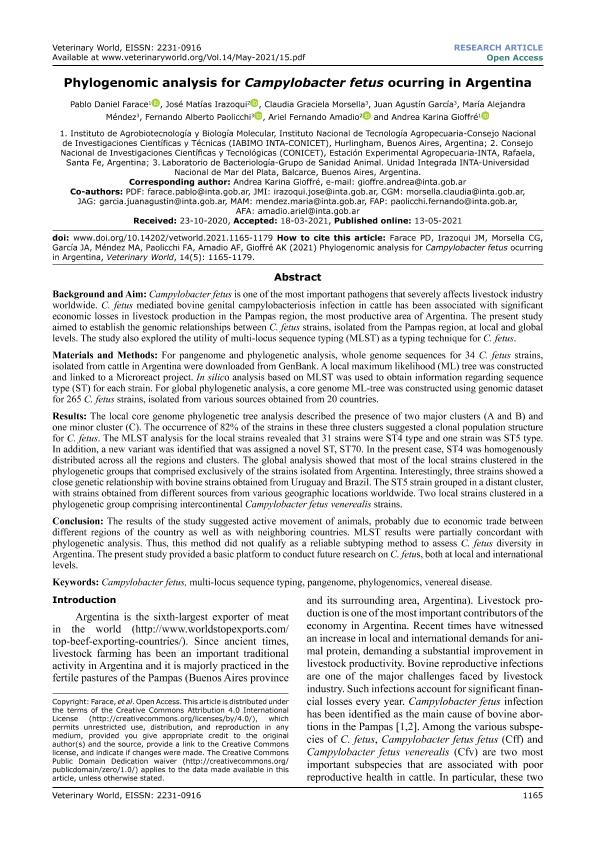Artículo
Phylogenomic analysis for Campylobacter fetus ocurring in Argentina
Farace, Pablo Daniel ; Irazoqui, José Matías
; Irazoqui, José Matías ; Morsella, Claudia Graciela; García, Juan Agustín
; Morsella, Claudia Graciela; García, Juan Agustín ; Méndez, Maria Alejandra; Paolicchi, Fernando Alberto; Amadio, Ariel Fernando
; Méndez, Maria Alejandra; Paolicchi, Fernando Alberto; Amadio, Ariel Fernando ; Gioffré, Andrea Karina
; Gioffré, Andrea Karina
 ; Irazoqui, José Matías
; Irazoqui, José Matías ; Morsella, Claudia Graciela; García, Juan Agustín
; Morsella, Claudia Graciela; García, Juan Agustín ; Méndez, Maria Alejandra; Paolicchi, Fernando Alberto; Amadio, Ariel Fernando
; Méndez, Maria Alejandra; Paolicchi, Fernando Alberto; Amadio, Ariel Fernando ; Gioffré, Andrea Karina
; Gioffré, Andrea Karina
Fecha de publicación:
05/2021
Editorial:
Veterinary World
Revista:
Veterinary World
ISSN:
0972-8988
e-ISSN:
2231-0916
Idioma:
Inglés
Tipo de recurso:
Artículo publicado
Clasificación temática:
Resumen
Background and Aim: Campylobacter fetus is one of the most important pathogens that severely affects livestock industry worldwide. C. fetus mediated bovine genital campylobacteriosis infection in cattle has been associated with significant economic losses in livestock production in the Pampas region, the most productive area of Argentina. The present study aimed to establish the genomic relationships between C. fetus strains, isolated from the Pampas region, at local and global levels. The study also explored the utility of multi‐locus sequence typing (MLST) as a typing technique for C. fetus. Materials and Methods: For pangenome and phylogenetic analysis, whole genome sequences for 34 C. fetus strains, isolated from cattle in Argentina were downloaded from GenBank. A local maximum likelihood (ML) tree was constructed and linked to a Microreact project. In silico analysis based on MLST was used to obtain information regarding sequence type (ST) for each strain. For global phylogenetic analysis, a core genome ML‐tree was constructed using genomic dataset for 265 C. fetus strains, isolated from various sources obtained from 20 countries. Results: The local core genome phylogenetic tree analysis described the presence of two major clusters (A and B) and one minor cluster (C). The occurrence of 82% of the strains in these three clusters suggested a clonal population structure for C. fetus. The MLST analysis for the local strains revealed that 31 strains were ST4 type and one strain was ST5 type. In addition, a new variant was identified that was assigned a novel ST, ST70. In the present case, ST4 was homogenously distributed across all the regions and clusters. The global analysis showed that most of the local strains clustered in the phylogenetic groups that comprised exclusively of the strains isolated from Argentina. Interestingly, three strains showed a close genetic relationship with bovine strains obtained from Uruguay and Brazil. The ST5 strain grouped in a distant cluster, with strains obtained from different sources from various geographic locations worldwide. Two local strains clustered in a phylogenetic group comprising intercontinental Campylobacter fetus venerealis strains. Conclusion: The results of the study suggested active movement of animals, probably due to economic trade between different regions of the country as well as with neighboring countries. MLST results were partially concordant with phylogenetic analysis. Thus, this method did not qualify as a reliable subtyping method to assess C. fetus diversity in Argentina. The present study provided a basic platform to conduct future research on C. fetus, both at local and international levels.
Archivos asociados
Licencia
Identificadores
Colecciones
Articulos (IDICAL)
Articulos de INSTITUTO DE INVESTIGACION DE LA CADENA LACTEA
Articulos de INSTITUTO DE INVESTIGACION DE LA CADENA LACTEA
Citación
Farace, Pablo Daniel; Irazoqui, José Matías; Morsella, Claudia Graciela; García, Juan Agustín; Méndez, Maria Alejandra; et al.; Phylogenomic analysis for Campylobacter fetus ocurring in Argentina; Veterinary World; Veterinary World; 14; 5; 5-2021; 1165-1179
Compartir
Altmétricas



